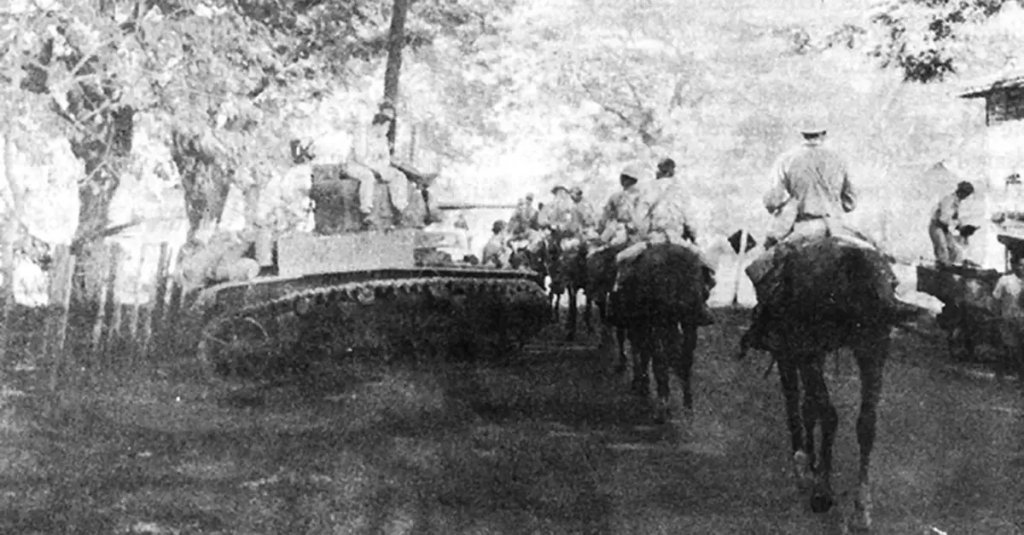While Poland is sometimes mocked for sending horse cavalry against tanks in World War II (it was actually horses against an infantry battalion, but still), the U.S. launched its own final cavalry charge two years later, breaking up a Japanese attack in the Philippines that bought time for the cavalrymen and other American troops.

It came in April 1942 as part of the months-long effort to defend the Philippines from the Japanese invasion. The first Japanese attacks on the islands took place on the same day as the Pearl Harbor attack (though it was December 8 on the calendar because the international dateline falls between the two). Just two days later, the week of troop landings began.
The Americans on the Philippines weren’t ready for the fight, and U.S. Gen. Douglas MacArthur had to lean hard on his elite troops to protect the rest of the force as they withdrew to one defensive line after another. And cavalry was uniquely suited for that mission since it could ride out, disrupt an attack, and then quickly ride back to where the rest of the defenders had fortified themselves.
And so MacArthur called up the 26th Cavalry (Philippine Scouts), a unit that had American officers and Filipino enlisted men on horses. And all of them were well-equipped and good at their jobs.
But, like the rest of the American forces there, they faced a daunting enemy. The Japanese invaders were nearly all veterans from fighting in Korea or Manchuria, but few of the American defenders had seen combat. And the Japanese forces were better armed.
So much so that, unlike Poland, the American cavalry really did once charge tanks from horseback. Oh, and it worked.
The cavalry scouts were exhausted from days of acting as the eyes and ears of the Army, but a new amphibious operation on December 22 had put Japanese forces on the road to Manila. The defenders there crumbled in the following days and completely collapsed on January 16, 1942. If the 26th couldn’t intercept them and slow the tide, Manila would be gone within hours.
The American and Filipino men scouted ahead on horseback and managed to reach the village of Morong ahead of Japanese forces. The village sat on the Batalan River, and if the cavalrymen could prevent a crossing, they could buy precious hours.
But as they were scouting the village, the Japanese vanguard suddenly appeared on the bridges. The commander had no time, no space for some well-thought-out and clever defense from cover. It was a “now-or-never” situation, and the 26th had a reputation for getting the job done.
So, the commander, Col. Clint Pierce, ordered a charge.
The men and horses surged forward, pistols blazing, at a vanguard of Japanese infantry backed up by tanks. But the American cavalry charge was so fierce that the Japanese ranks broke, and they dodged back across the river to form back up. It was so chaotic that even the tanks were forced to stop.
“Bent nearly prone across the horses’ necks, we flung ourselves at the Japanese advance, pistols firing full into their startled faces,” First Lt. Edwin Ramsey, a platoon leader, later wrote. “A few returned our fire but most fled in confusion. To them we must have seemed a vision from another century, wild-eyed horses pounding headlong; cheering, whooping men firing from the saddles.”
And so the cavalrymen held the line, dismounting after the first charge but preventing the Japanese crossing.

While the Philippine Scouts would be well decorated for their endeavors on January 16, and for other heroics during the defense of the Philippines, the story turns grim for them.
They took heavy losses that day before falling back to the rest of the American force after reinforcements arrived. And then they were isolated on the Bataan Peninsula. As the American forces began to starve, they butchered the horses and ate the meat. But even that wouldn’t be enough.
On April 9, 1942, the U.S. forces on the Bataan Peninsula surrendered to the Japanese. At least 600 Americans and 5,000 Filipinos were killed in the death march that followed.
That same month, the last U.S. Army horse cavalry unit turned in its animals in Nebraska.


